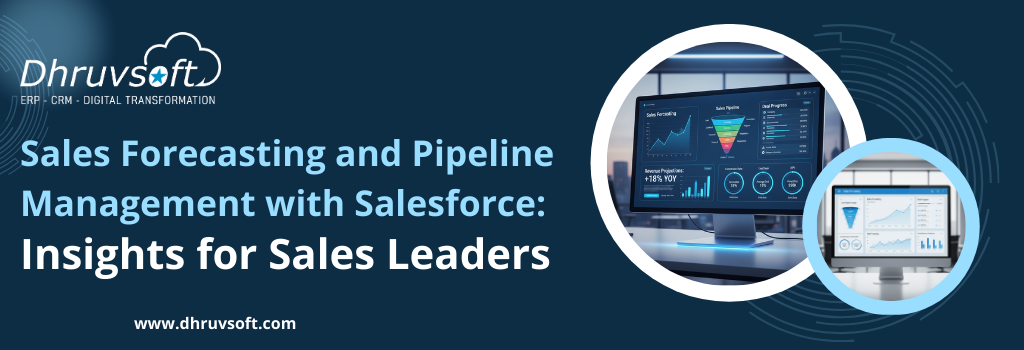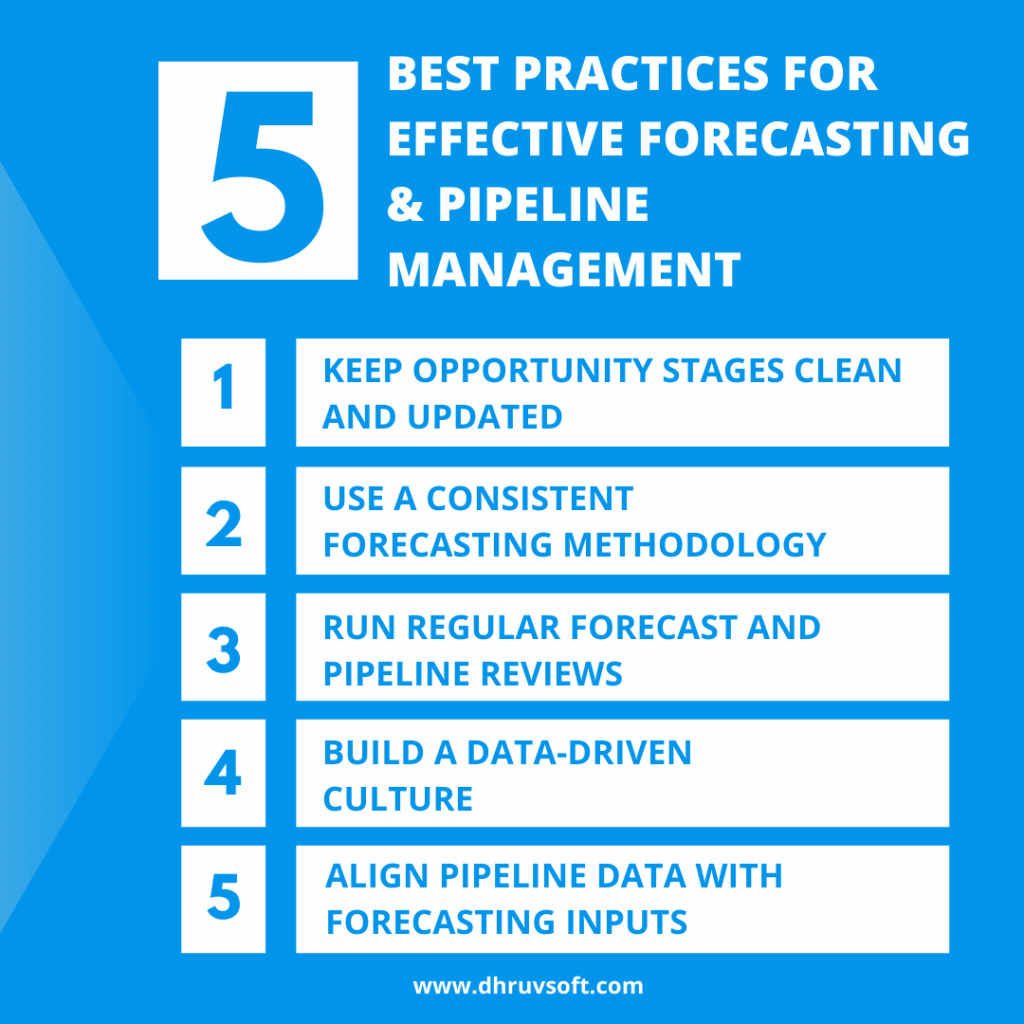
Forecasting sales and managing the sales pipeline are two of the most critical responsibilities for any organization aiming for predictable growth. Yet, these tasks often become challenging due to inconsistent data, manual processes, and a lack of real-time visibility. Many sales teams struggle with inaccurate forecasts because their pipeline information is outdated, incomplete, or scattered across spreadsheets.
Salesforce addresses these challenges by offering an integrated, automated, and data-driven approach to forecasting and pipeline management. With real-time dashboards, structured opportunity stages, AI-driven predictions, and collaborative forecasting tools, Salesforce gives organizations the clarity they need to plan confidently.
Dhruvsoft further strengthens this process by implementing Salesforce best practices, configuring powerful forecasting models, and training teams to maintain strong pipeline hygiene.When businesses combine accurate forecasting with complete pipeline visibility, they unlock predictable and sustainable revenue growth. This is the foundation of strong sales performance—and Salesforce makes it achievable.
Why Accurate Sales Forecasting Matters
A sales forecast is an estimation of the revenue a business expects to generate within a defined period, such as a month, quarter, or year. Salesforce defines forecasting as a combination of the expected revenue amount and the timeframe in which deals are likely to close. It is a forward-looking view created from real opportunity data, historical results, and deal trends.
Accurate forecasting supports essential business functions like resource planning, budgeting, performance monitoring, and strategic goal-setting. When forecasts are reliable, leadership can plan investments, scale operations, align marketing activities, and prepare product or service capacities based on expected demand.
However, poor forecasting can disrupt the entire business. Companies may overspend due to overly optimistic revenue assumptions, or they may under-prepare for growth and miss market opportunities. Sales teams may also miss quotas because their pipelines were inflated or inaccurately represented. Inaccurate forecasting leads to misalignment across departments and reduces leadership’s confidence in the sales process. This is why organizations must build forecasting discipline and why Salesforce’s structured system is so valuable.
Understanding Salesforce’s Approach to Forecasting
Salesforce Sales Cloud Forecasting functionality provides a structured and transparent method for projecting revenue. Salesforce defines a forecast using two key components: (1) Opportunity amount and (2) Close timeframe. Because forecasting is built directly within the CRM, it updates automatically whenever opportunity data changes.
Salesforce emphasises the importance of a strong data culture. Forecast accuracy improves dramatically when sales reps update stages, values, close dates, and next steps consistently. Real-time insights ensure that managers and leaders always have a clear picture of sales performance and revenue expectations.The Salesforce’s approach encourages collaboration between sales reps, managers, product leaders, finance teams, and executives. Forecast roll-ups enable everyone to contribute, verify, and adjust forecast numbers together. The result is an accurate, real-time snapshot of the organization’s expected sales.
Key Forecasting Elements
Salesforce forecasting depends on clear ownership and collaboration. Sales representatives are responsible for updating their opportunities accurately. Sales managers validate these updates, refine forecast categories, and ensure deal probabilities match reality. Product teams use forecast data for demand planning, and finance teams rely on forecasts for budgeting and revenue planning.
Across the organization, various teams depend on accurate forecasts:
- Finance: revenue planning, cash flow, budgets
- Product & Supply Chain: demand forecasting and inventory
- Marketing: campaign planning aligned with revenue cycles
- HR: workforce planning and hiring
The core objective of Salesforce forecasting is to present a clear view of expected sales, enabling leadership to make informed decisions. Salesforce makes this possible, helping teams align on expectations – through standardised categories such as:
- Pipeline
- Best Case
- Commit
- Closed
Why Salesforce Makes Forecasting Better
Many organizations still use spreadsheets or manual processes for forecasting, which leads to outdated information, human errors, and slow decision-making. Salesforce eliminates these problems by automating the entire forecasting process.
CRM-based forecasting offers several advantages:
- Real-time visibility into the pipeline
- Automated roll-ups across reps, teams, and territories
- Consistent forecasting methodology
- Instant access to structured dashboards and analytics
Salesforce also integrates backend data with AI through Salesforce Einstein. This enhances forecasting accuracy by analysing patterns, predicting outcomes, and identifying risks. Einstein provides insights like opportunity scoring, conversion likelihood, and pipeline movement trends—all of which help leaders build more reliable forecasts.
Pipeline Management with Salesforce: Building the Foundation
Forecast accuracy depends entirely on the health of the sales pipeline. If the pipeline contains outdated, inaccurate, or inflated deals, forecasts will always be unreliable. Salesforce helps organizations build a clean, structured, and disciplined pipeline that forms the basis of accurate forecasting.
Strong pipeline management in Salesforce revolves around key elements:
- Clearly defined opportunity stages
- Consistent activity tracking (calls, meetings, emails)
- Accurate close dates, amounts, and probability values
- Transparent deal movement and history
- Validation rules that enforce data completeness
A clean pipeline ensures that forecasts reflect reality. By aligning up-to-date pipeline data with forecasting inputs, organizations can trust their revenue projections and make more confident decisions.
Reporting, Dashboards & Analytics: Turning Pipeline into Insight
Salesforce’s reporting and dashboard capabilities transform pipeline data into meaningful and actionable insights. Visual dashboards allow sales leaders to monitor pipeline health, identify gaps, track performance, and verify forecast accuracy.
Salesforce dashboards commonly include:
- Pipeline value by stage
- Forecast vs achievement trends
- Leader-boards for sales reps
- Roll-ups by territory or product family
- Deal with aging and stalled opportunities
- Commit vs Best Case analysis
These dashboards refresh automatically in real-time as sales reps update opportunities. This ensures that leaders always review the latest data, making weekly pipeline reviews and monthly forecasting cycles more productive and accurate.Keeping the data updated frequently and reviewing it at each milestone is essential. Salesforce makes it easy for sales leaders to stay consistent with these review cycles.
Leveraging AI & Predictive Insights in Salesforce
AI is becoming an essential part of modern forecasting, and Salesforce has built predictive intelligence directly into its CRM. Einstein Forecasting analyses historical performance, deal patterns, buyer activity, and pipeline movement to deliver predictive insights.
Some of these AI-powered features include:
- Opportunity scoring to show how likely a deal is to close
- Trend analysis to identify positive or negative momentum
- Forecast predictions based on historical results
- Risk alerts for stalled or declining deals
- Predictive dashboards highlighting future revenue gaps
These AI insights help sales teams reduce guesswork, prioritise the right opportunities, anticipate risks earlier, and adjust strategies faster.
Best Practices for Effective Forecasting & Pipeline Management
To fully benefit from Salesforce’s forecasting and pipeline capabilities, organizations should follow best practices:
- Keep opportunity stages clean and updated: Ensure each deal accurately reflects its current status and follows defined stage guidelines.
- Use a consistent forecasting methodology: Follow the same time periods, categories, and calculation standards across the organization.
- Run regular forecast and pipeline reviews: Weekly rep reviews and monthly management reviews keep data aligned with real performance.
- Build a data-driven culture: Encourage teams to maintain accurate opportunity data and avoid inflated pipelines.
- Align pipeline data with forecasting inputs: A forecast should only reflect opportunities supported by real evidence and updated information.
By combining strong processes with Salesforce tools, businesses significantly improve their forecasting accuracy.
How Dhruvsoft Enables Success with Salesforce Forecasting
Dhruvsoft helps organizations unlock the full potential of Salesforce by setting up forecasting models, dashboards, and analytics tailored to business needs. The team configures Collaborative Forecasting, opportunity stages, and validation rules that enforce data accuracy.
Dhruvsoft also trains sales reps and leaders on forecasting discipline, pipeline hygiene, and data-driven decision-making. With continuous optimization support, Dhruvsoft ensures that forecasting models evolve with market changes and organizational growth.
Mini Example: A client struggling with inconsistent forecasting partnered with Dhruvsoft to implement Salesforce forecasting. Dhruvsoft restructured opportunity stages, created forecasting dashboards, and trained the team. Within one quarter, the client reported a 40% improvement in forecast accuracy and higher visibility into rep performance, building long-term confidence across departments.This demonstrates Dhruvsoft’s expertise and commitment to delivering accurate, reliable forecasting systems.
Common Mistakes to Avoid
Even with powerful tools, forecasting can fail if best practices aren’t followed. Common mistakes include:
- Relying on intuition instead of data (only a small number of leaders trust their forecasts due to inaccurate data)
- Not updating pipeline information on time, leading to unrealistic forecasts
- Using spreadsheets instead of CRM systems, causing data silos and errors
- Ignoring external shocks without adjusting forecasts for changing market conditions
- Lack of alignment between sales, product, and finance teams, resulting in inconsistent numbers
Salesforce and Dhruvsoft help eliminate these pitfalls by building a structured, data-driven forecasting approach.
Conclusion
Accurate forecasting and healthy pipeline management form the backbone of predictable revenue growth. Salesforce provides everything sales teams need—real-time visibility, structured forecasting categories, advanced dashboards, and AI-powered predictions—to build an accurate and trustworthy forecasting system.
With Dhruvsoft’s expertise in Salesforce implementation, configuration, and ongoing optimization, organizations can take full advantage of Salesforce’s forecasting capabilities. Dhruvsoft ensures clarity, discipline, and accuracy across every stage of the forecasting cycle. Businesses looking to strengthen their forecasting and pipeline strategy should explore how Salesforce and Dhruvsoft can help them achieve sales excellence.

